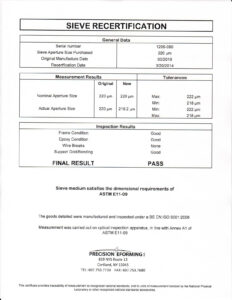At Precision Eforming, we offer sieve certification services to certify your micron sieve for the first time or re-certify your test sieve to ensure it is still working at its ultimate performance level.
We recommend annual re-certification of electroformed test sieves, as normal wear from use is inevitable. Wear can sometimes result in inaccurate performance results. Sieves should therefore be re-inspected to ensure they continue to comply with their intended specification. Especially Ultra Precision sieves which have an initial tolerance of +/-1um.
Precision Eforming also performs re-certifications of wire woven sieves upon request.
Precision Eforming sieve re-examination and recertification service provides the same quality and documentation that you would receive at other certification labs, but at a lower per piece cost and with a faster turnaround.
Sieve Recertification Service includes:
- A visual check for broken wires or damaged mesh, repair of broken wires unless the damage is deemed too excessive.
- A visual check of solder joints for crevices, repair if needed.
- A gauge check on the diameter and roundness of the sieve frame and rim.
- Measurement of the opening and evaluation of compliance to the appropriate current specification using NIST calibrated measurement equipment suitable for the aperture size and sieve material.
- A serialized histogram of the aperture openings, one per sieve.
- Appropriate certification.
Rejected sieves
Sieves not passing at standard tolerance will be returned, labelled as “FAIL”.
Timescale
The examination will normally take 1-2 days after receipt of sieve at our facility. If you are requesting that a significant amount of sieves be recertified, Precision Eforming will develop a schedule with you that limits the time your sieves are out of your facility.
Note
Please note that sieves for recertification must be clean and free from contamination and blinding as much as possible. A sieve that is unreadable for these reasons will be considered a “FAIL”
